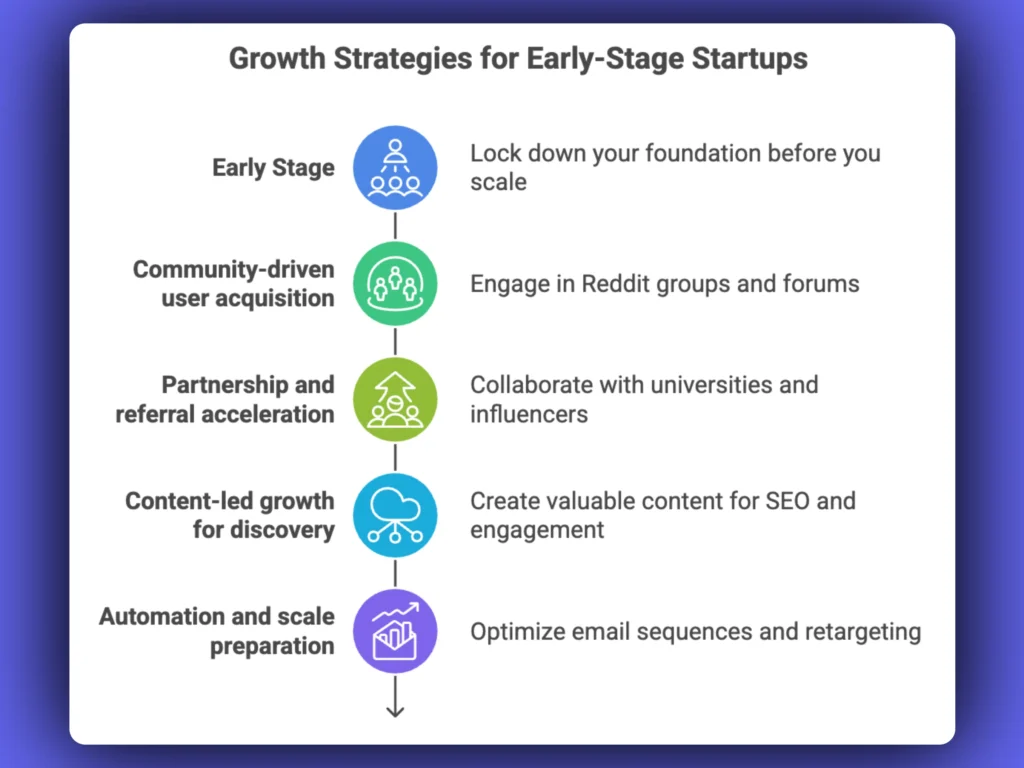Here’s what every founder needs to know: growth hacking is the go-to marketing response for bootstrapped startups that need customers without burning through runway. This isn’t about magic tricks or viral stunts, it’s about systematically finding creative, data-driven ways to acquire your first paying users before you can afford traditional marketing campaigns.
If you’ve just launched your SaaS and you’re staring at zero users, this playbook will walk you through the exact strategies that work. We’ll cover everything from validating your messaging to automating user acquisition, all while building the foundation for scalable growth.
What Real Founders Are Asking About Early-Stage Growth
Before diving into tactics, let’s address the burning questions we see across startup communities:
From u/StartupStruggle on r/startups: “How do I get my first 10 paying customers when nobody knows my product exists?”
From u/SaaSFounder22 on r/entrepreneur: “Is it worth spending on ads when I have a $2K monthly budget and my CAC is already $150?”
These questions reveal a common challenge: early-stage startups need growth strategies that work with limited budgets and zero brand recognition. The solution lies in growth hacking, but done strategically, not randomly.

Step 1: Lock Down Your Foundation Before You Scale
The early days are a whirlwind, but growth should remain crystal clear as the lifeblood that propels you from idea to thriving business. Before you start acquiring users, you need four foundational elements:
- Perfect Your Core Messaging Your tagline needs to communicate value in seconds. If someone can’t understand what you do and why they need it within 10 seconds of landing on your site, you’ll hemorrhage traffic. Test your messaging with real users, not your team.
- Nail Your Pricing Strategy Freemium models work because they reduce friction. Free trials and limited versions get people hooked and drive paid conversions, it’s the driving force behind product-led growth that’s created SaaS unicorns like Calendly and Slack. Structure your tiers so users hit value quickly but need to upgrade for sustained use.
- Create Instant Value Demos Your product demo shouldn’t be a feature tour, it should solve a specific problem in under 3 minutes. Show the transformation, not the tool.
- Set Up Basic Tracking You can’t optimize what you don’t measure. At minimum, track user acquisition sources, activation rates, and time-to-first-value. Use tools like Mixpanel or Amplitude for granular insights.
Step 2: The Freemium Trial Approach
Here’s a growth hacking strategy that scales while building relationships: offering a targeted freemium trial. It works because you’re delivering instant value while showcasing your product in action.
The Boolean Search Approach
Set up automated searches for posts using keywords in your industry combined with phrases like “just launched,” “built this,” “new feature,” or “need feedback.” For example:
"workflow automation" + "just launched""customer success platform" + "need feedback""SaaS tool" + "beta testing"
The Outreach Formula
When you find relevant conversations or product launches:
- Respond with something thoughtful and specific, not a canned message
- Offer 2–3 ways your product could help, based on what they shared
- Invite them to try your tool with a freemium link tied to their exact use case
- Avoid hard-selling, let the value speak for itself
This approach drives product signups and builds visibility because you’re offering help, not hype.
Step 3: Community-Driven User Acquisition
Reddit Groups and specialized forums are where your ideal customers gather, and Reddit posts have high authority on Google while being less saturated for B2B SaaS. But community marketing requires finesse.
The Reddit Playbook
- Find Your Subreddits: Target communities where your users hang out (/r/startups, /r/entrepreneur, /r/webdev, industry-specific subs)
- Provide Value First: Answer questions genuinely for weeks before mentioning your product
- Use the 90/10 Rule: 90% valuable content, 10% subtle product mentions
- Time Your Posts: Post when your target audience is most active (usually weekdays, early morning or evening)
Build Your Own Community Hub
While participating in existing communities is crucial, creating your own Q&A forum or community space serves multiple growth purposes:
- SEO Authority Building: Build topical authority and user-generated content around your product creates long-tail keyword opportunities
- Customer Success Automation: Users help each other, reducing your support load
- Product Development Insights: Direct feedback loop for feature requests and pain points
- Referral Engine: Satisfied community members become organic advocates
Start simple with tools like Discord, Circle, or even a dedicated section on your website. Focus on solving one specific problem your audience faces, then gradually expand topics as the community grows.
Product Hunt Launch
Save this for last, after you’ve built some community presence and user base. A successful Product Hunt launch requires preparation: hunter outreach, social media coordination, and a follow-up email sequence.
Step 4: Signal-Based Outreach That Converts
Traditional cold outreach feels spammy. Signal-based outreach targets people showing intent.
Job Title Targeting: Use tools like Apollo or Clay to find prospects with relevant job titles who are actively hiring or posting about challenges your product solves. Keywords like “QA engineer,” “DevOps specialist,” or “growth marketer” can indicate immediate need.
The LinkedIn Approach Instead of generic connection requests:
- Reference specific content they’ve shared
- Offer a relevant resource (case study, template, audit)
- Suggest a brief call to discuss their challenges
- Follow up with value, not sales pitches
GitHub Marketing for Developer Tools: If you’re building for developers, GitHub is goldmine. Find repositories related to your solution, contribute genuinely to discussions, and offer your tool as a solution to specific issues raised in commits or issues.
Step 5: Partnership and Referral Acceleration
Early-stage partnerships can dramatically reduce your customer acquisition cost while building credibility.
University and Student Discounts Reach out to computer science departments, business schools, and startup incubators. Students become advocates and often transition into paying enterprise customers post-graduation.
VC and Startup Community Partnerships Offer special pricing to portfolio companies of specific VCs. VCs love providing value to their portfolio, and startups in the same cohort often share tools and strategies.
AppSumo: The Early Revenue and Awareness Generator AppSumo launches are game-changers for early-stage SaaS. Here’s why they work:
- Immediate Revenue Stream: Generate $10K-$50K+ in upfront revenue from early adopters
- User Base Explosion: Access to AppSumo’s 1M+ subscriber base of entrepreneurs and small business owners
- Social Proof Boost: Thousands of users provide reviews, testimonials, and case studies
- Retargeting Gold Mine: Build email lists for follow-up campaigns driving G2 reviews, GitHub stars, or referrals
The key is timing, launch on AppSumo after you’ve validated product-market fit but before you need massive scale. Use the revenue to fund growth experiments and the user feedback to refine your product.
Influencer Collaborations: Partner with micro-influencers in your space. Look for industry experts with 1K-10K engaged followers rather than mega-influencers. Their audiences are more likely to convert because trust levels are higher.
Step 6: Content-Led Growth for Discovery
Simple tools that deliver instant value without registration, like ROI calculators, idea generators, or interactive quizzes, get shared naturally when they address specific pain points.
SEO Strategy for Early-Stage Startups: Focus on long-tail keywords your competitors ignore:
- “How to [specific task] for [specific industry]”
- “[Tool type] for [company size]”
- “Alternative to [competitor] for [use case]”
Founder-Led Content: Share your building journey, lessons learned, and industry insights. Authenticity beats polish in early stages. Use LinkedIn, Twitter, and relevant podcasts to build thought leadership.
Signal-Based Content Creation: Monitor communities like Reddit for frequently asked questions, then create content that answers them comprehensively. This content becomes a lead magnet when shared in those same communities.
Step 7: Automation and Scale Preparation
As you gain traction, automate what you can to maintain growth velocity.
Email Sequence Optimization Build sequences for different user segments:
- Trial users who haven’t activated
- Users who’ve activated but haven’t upgraded
- Churned users (win-back campaigns)
- Referral requests for satisfied customers
Retargeting Setup Even with a small budget, retargeting converts well. Create audiences based on specific actions (demo viewed, pricing page visited, trial started) and serve relevant content.
Customer Success Automation Proactive outreach prevents churn. Set up automated emails when users hit (or don’t hit) key milestones. Personal touches at critical moments can dramatically improve retention.
The Metrics That Matter for Early-Stage Growth
Track these key metrics to optimize your growth efforts:
User Acquisition:
- Cost per acquisition (CPA) by channel
- Time from first touch to trial signup
- Trial-to-paid conversion rate
- Monthly active user growth rate
Product-Market Fit Indicators:
- Time to first value (how quickly users get value)
- Feature adoption rates
- Net Promoter Score (NPS)
- Customer lifetime value to CAC ratio
Growth Velocity:
- Weekly/monthly growth rates
- Referral rates and viral coefficient
- Expansion revenue from existing customers
- Churn rate and reasons for churning
Common Pitfalls to Avoid
- Spraying and Praying: Don’t try every growth channel simultaneously. Growth hacking is an experiment-driven technique, focus on 2-3 channels, optimize them, then expand.
- Focusing on Vanity Metrics: Downloads, signups, and social followers don’t pay the bills. Focus on metrics tied to revenue: trial-to-paid conversion, customer lifetime value, and monthly recurring revenue growth.
- Neglecting Retention for Acquisition: A leaky bucket never fills. If your churn rate is above 5-7% monthly, fix retention before scaling acquisition. It’s cheaper to keep customers than acquire new ones.
- Underestimating Timeline: Growth hacking isn’t instant. Most tactics take 3-6 months to show significant results. Plan for consistency and patience.
Your Next Steps: From Strategy to Execution
Start with these three actions this week:
- Audit Your Foundation: Review your messaging, pricing, and demo flow. Can a stranger understand your value proposition in 10 seconds?
- Choose Your First Channel: Pick one community-based acquisition channel (Reddit, LinkedIn, or industry forums) and commit to providing value daily for 30 days.
- Set Up Basic Tracking: Implement event tracking for key user actions so you can measure what’s working.
The path from zero to 100 paying users isn’t about finding one silver bullet, it’s about systematically testing, measuring, and scaling what works while building genuine relationships with your early community.
Remember: growth hacking isn’t about shortcuts or get-rich-quick schemes, it’s about systematically finding creative ways to engineer growth. The startups that succeed long-term are those that blend creative tactics with solid fundamentals and consistent execution.
If you are ready to scale your early-stage SaaS with growth hacking strategies book a free consultation call.
